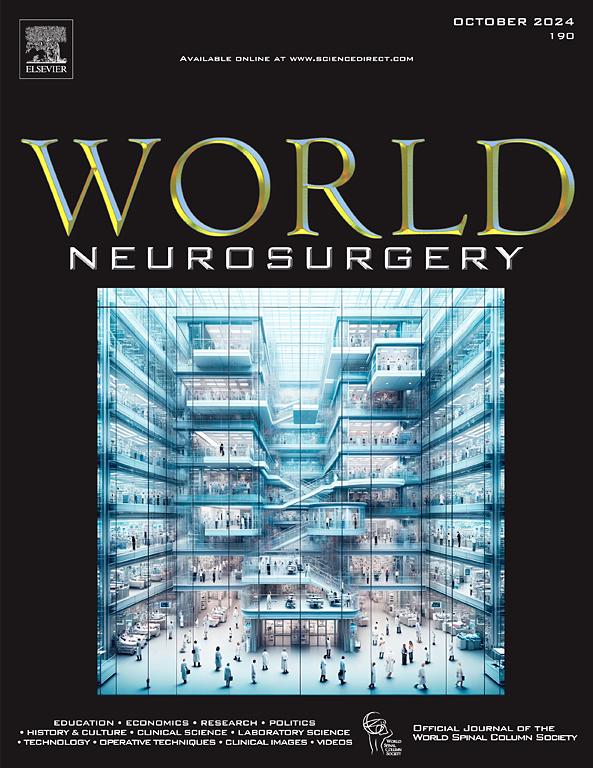使用机器学习预测前循环大血管闭塞缺血性卒中患者取栓后24小时血压变异性
IF 1.9
4区 医学
Q3 CLINICAL NEUROLOGY
引用次数: 0
摘要
背景:机械取栓是大血管闭塞缺血性脑卒中患者的标准治疗方法。取栓后血压变异性(BPV)与不良的功能预后相关。为了确定与BPV增加相关的预测因素,使用机器学习算法来识别与取栓后24小时(24HR) BPV指数增加相关的因素。方法:本回顾性研究检查了综合卒中中心登记的2016年1月至2019年12月期间接受机械取栓术的所有患者。主要结局是取栓后再灌注充足的患者(脑梗死溶栓[TICI]分级2b+)和没有再灌注充足的患者之间的BPV。次要结局为90天功能状态良好(改良Rankin量表[mRS]≤2)和再灌注(TICI 2b+)。随机森林(RF)分析利用报告的均方根误差(RMSE)和标准化RMSE (nRMSE)指标来确定BPV的预测因子。采用多变量回归分析确定与次要结局显著相关的因素。结果:共纳入395例患者,其中女性195例占49%,男性200例占51%,平均年龄(±标准差)为65(±15)岁。322例(82%)患者达到了TICI 2b+。ASPECTS和NIHSS的中位数分别为9和18。在多变量回归分析中,年龄、NIHSS、通过次数和机械通气与90天mRS≤2的可能性降低显著相关。结论:该研究确定了从最后一次已知时间到腹股沟穿刺的间隔时间、年龄和NIHSS是RF分析中与24HR BPV增加显著相关的因素。在我们的机器学习分析中,这些诱发因素使临床医生能够识别有BP增高风险的患者,并有机会加强这些患者的BP控制。本文章由计算机程序翻译,如有差异,请以英文原文为准。

Predicting 24-Hour Blood Pressure Variability Post Thrombectomy Using Machine Learning for Patients with Ischemic Stroke from Anterior Circulation Large Vessel Occlusion
Background
Mechanical thrombectomy is the standard of care for patients with ischemic stroke from large vessel occlusion. Blood pressure variability (BPV) in the post thrombectomy period is associated with poor functional outcomes. To determine predictive factors associated with increased BPV, a machine learning algorithm was used to identify factors that are linked with increased BPV indices at 24 hours post thrombectomy.
Methods
This retrospective study examined all patients from a Comprehensive Stroke Center's registry who underwent mechanical thrombectomy between January 2016 and December 2019. The primary outcome was BPV between patients who had adequate reperfusion post thrombectomy (Thrombolysis in Cerebral Infarction [TICI] grading 2b+) and those who did not. The secondary outcomes were good functional status at 90 days (modified Rankin Scale ≤2) and reperfusion (TICI 2b+). Random forest analysis was leveraged to determine predictors for BPV with reported root mean square error and normalized root mean square error metrics. Multivariable regression analysis was used to determine factors significantly associated with secondary outcomes. P < 0.05 was the threshold for statistical significance.
Results
A total of 395 patients (49%, n = 195 females and 51%, n = 200 males) were included in the final analysis with mean age (± standard deviation) of 65 (±15) years. TICI 2b+ was achieved in 322 (82%) patients. Median Alberta stroke program early CT score and National Institutes of Health Stroke Scale (NIHSS) were 9 and 18, respectively. Higher age, NIHSS, number of passes, and mechanical ventilation were significantly associated with lower likelihood of modified Rankin Scale ≤2 at 90 days in multivariable regression analysis.
Conclusions
This study identified the interval from last-known-well time-to-groin puncture, age, and NIHSS as factors significantly associated with increased 24-hour BPV in random forest analysis. These predisposing factors in our machine learning analysis allow clinicians to identify patients who are at risk of having increased BPV and opportunities to augment these patients' blood pressure control.
求助全文
通过发布文献求助,成功后即可免费获取论文全文。
去求助
来源期刊

World neurosurgery
CLINICAL NEUROLOGY-SURGERY
CiteScore
3.90
自引率
15.00%
发文量
1765
审稿时长
47 days
期刊介绍:
World Neurosurgery has an open access mirror journal World Neurosurgery: X, sharing the same aims and scope, editorial team, submission system and rigorous peer review.
The journal''s mission is to:
-To provide a first-class international forum and a 2-way conduit for dialogue that is relevant to neurosurgeons and providers who care for neurosurgery patients. The categories of the exchanged information include clinical and basic science, as well as global information that provide social, political, educational, economic, cultural or societal insights and knowledge that are of significance and relevance to worldwide neurosurgery patient care.
-To act as a primary intellectual catalyst for the stimulation of creativity, the creation of new knowledge, and the enhancement of quality neurosurgical care worldwide.
-To provide a forum for communication that enriches the lives of all neurosurgeons and their colleagues; and, in so doing, enriches the lives of their patients.
Topics to be addressed in World Neurosurgery include: EDUCATION, ECONOMICS, RESEARCH, POLITICS, HISTORY, CULTURE, CLINICAL SCIENCE, LABORATORY SCIENCE, TECHNOLOGY, OPERATIVE TECHNIQUES, CLINICAL IMAGES, VIDEOS
 求助内容:
求助内容: 应助结果提醒方式:
应助结果提醒方式:


